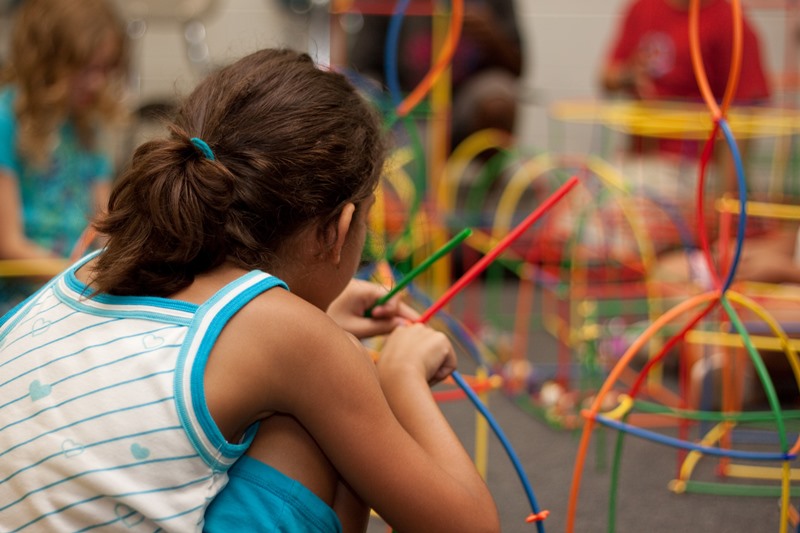
To Educate the Human Potential, p. 80.
Recently, there has been a lot of discussion about children needing more time to play. Studies suggest spending time playing is more beneficial than spending time in the classroom. Play is being touted as the answer to everything from low test scores to behavior challenges.
But wait a minute … if that were true, wouldn’t Montessori classrooms have hours of play time built into the day? Wouldn’t the emphasis in the Montessori environment be on play and not on learning? Wouldn’t Montessori children suffer from mental and emotional fatigue and academic overload? Wouldn’t they rebel in bouts of inappropriate behavior?
Montessori Today, Chapter 6: The Elementary Teacher — Work or Play
Almost 70 years ago, Dr. Montessori observed that reducing instructional time and increasing play do not work. Well-meaning adults, believing they are relieving children of the burden of learning are actually creating environments of increased mental fatigue, apathy, and dependence. What then, is the solution?
The answer is quite simple: work. “Montessori’s great discovery in the Children’s House was that work is the road to normality for children.” (Lillard, p. 90) Work brings about normalization in the early childhood environment, and it has great benefits in the elementary environment as well. Work, and not the lack of it, is liberating as long as the work is of interest to the child.

Have you ever been lost in your work, to the point where you have lost all track of time? Perhaps you have been in the garden and suddenly realized that you have spent the entire day working without stopping. Or maybe you have been writing a complex computer program, and when you glance at the clock, you realize you have worked straight through lunch. Often when we are doing something that we are really interested in and passionate about, we can spend the whole day doing it and come away feeling refreshed, energized, and ready for more. This same experience occurs consistently for students working in the Montessori environment.
In the Montessori elementary environment, the students themselves decide what they will learn based upon their own personal interests. The Montessori teacher does not decide which areas the students will explore, what lessons will be learned, or what work should be done. That is up to each individual student. Because of this, Montessori students’ learning is deeper and broader than students who learn through memorization and test taking.
The Montessori teacher’s responsibility, then, lies in observing each student to learn where his/her interests lie and to ascertain at what level she/he is performing. She does this for all subjects: The studies of history, geography, and science but also of language and math. Through her observations, the teacher is aware at what level the child is reading and doing math. Based on her observations, the next lessons and presentations may be made.
If the teacher misuses the presentations and materials by dictating to the children – telling them what areas to explore, how they are to explore them, what they are to discover, and when – the children’s behavior deteriorates. They lose their enthusiasm and energy and, one by one, they become increasingly reactive and dependent upon adult monitoring and control.

Increased play and/or reduced academic rigor are not solutions to over-tested standardized curriculum. Students who are interested in what they are learning will work without stopping. They will become self-directed learners, taking personal responsibility for their own learning. “We are concerned here with bringing [children] liberty and independence while interesting them in an activity through which they will subsequently discover reality. And for them this is the means by which they may free themselves from the adult.” (Montessori, From Childhood to Adolescence, p. 25)
Montessori discovered that an uninterrupted three-hour work cycle was the best way to allow children the freedom to pursue their own academic interests.
The work cycle should not be interrupted with physical education, computer classes, foreign language, art, etc., for to do that, is to once again impose the adult’s will on the students. Students do not need mental breaks from learning. Interruptions are just that; they break the cycle of concentration and are more harmful than they are beneficial. Though the temptation may be great, and the pressure from parents to conform may be mighty, schools that do not stray from the uninterrupted work cycle see greater growth in students’ independence, interest, and emotional and academic intelligence.When given the choice between work and recess, many of my elementary students preferred to stay in the classroom to work. Some took their work outside with them; others stayed in, unwilling to stop mid-thought. This happened, too, when it was time to go home. My upper elementary students would keep their parents waiting because they just did not want to stop working!
Play is not the solution. The only solution, according to Dr. Montessori, is work. “Work is not an option; it is a necessity …” (Lillard, p. 90)
© North American Montessori Center - originally posted in its entirety at Montessori Teacher Training on Friday, May 26, 2017.

0 comments:
Post a Comment
Have questions or comments? Let us know what you thought about this article!
We appreciate feedback and love to discuss with our readers further.